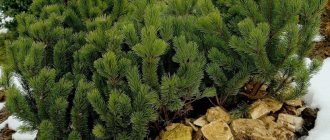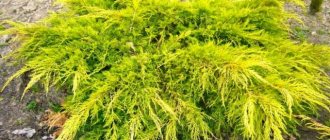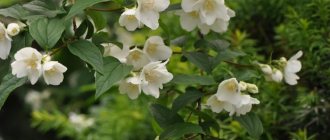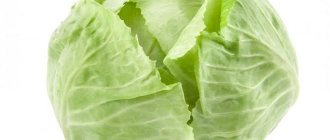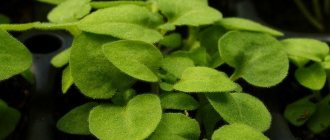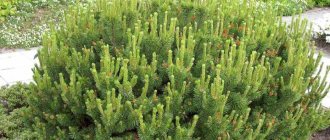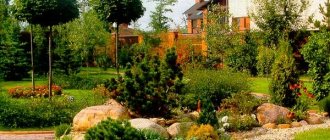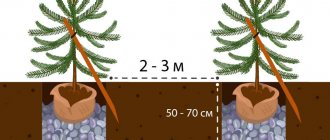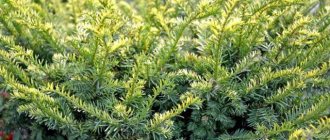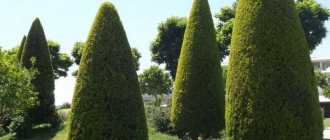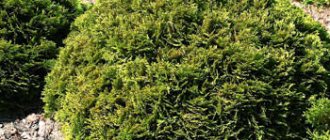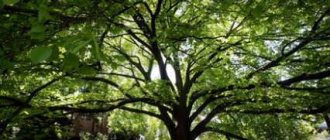Landscape designers often use dwarf pines when landscaping small areas. Coniferous plants on the site allow you to create spectacular landscape compositions.
Thanks to the variety of varieties of dwarf pines, each owner will be able to choose the ideal green space option.
Any of the varieties of mountain pine can be planted in a flower bed, lawn or alpine hill. You can also grow coniferous plants in tubs and containers.
What is dwarf pine
Dwarf pines are coniferous plants that are a type of mountain pines. There are more than 100 varieties of trees, the homeland of which is considered to be the mountainous southern regions of the country and central Europe. Most pine trees naturally grow in the upper boundaries of mountain forests.
The unpretentiousness of the plants is undoubtedly an advantage. Coniferous crops will not only effectively decorate any site design, but also, due to the presence of healing properties, will help:
- purify the air;
- relieve stress;
- normalize blood pressure.
Dwarf pines have spherical outlines. The growth of coniferous plantations is slow. The maximum height of dwarf trees reaches 120-140 cm. Every year the planting grows by 2.5-5 cm. Coniferous plantings can be propagated by cuttings. The shade of the needles of most varieties is dark green. Short shoots are located quite densely.
For planting, it is recommended to select well-lit areas on the site. In the first weeks after planting the seedlings, they need to be shaded with a special garden net. The soil for planting must be well drained.
Note! The evergreen, unpretentious shrub tolerates pruning well.
What to remember
- It is better to choose coniferous plants for the garden from three types: yew, cypress, and pine. They are most adapted to garden conditions.
- The most popular varieties of low-growing and dwarf conifers are: mountain pine "Winter Gold", balsam fir "Hudsonia", Lawson cypress "Minima Aurea", common juniper "Compress", Scots pine "Pendula", low-growing spruce "Nidiformis".
- Certain rules must be followed to create a healthy and harmonious landscape composition.
- You can create landscape compositions using ready-made designs.
- It is advisable to dilute compositions of coniferous plants with deciduous shrubs and flowers.
Tags: small, very, pine
About the author: admin4ik
« Previous entry
Advantages and disadvantages
Among the main advantages of dwarf pines, landscape designers highlight:
- Possibility of growing in small areas.
- Durability.
- A variety of varieties that differ in shape, color of needles and crown size.
- The ability to trim bushes to give them the desired shape.
- Easy to care for green spaces.
Among the disadvantages are:
- poor resistance to fungal infections (it is necessary to treat with fungicides and remove dry parts of the bushes);
- frequent branches breaking due to gusty winds;
- short lifespan;
- difficulties with reproduction (shoots obtained by cuttings take root poorly).
If you properly care for the shrub, you can avoid most problems with coniferous plants.
Pros and cons of dwarf trees
Positive qualities of dwarf species:
- dwarfs are miniature copies of tall species;
- do not require a large area for cultivation;
- go well with various plants and are decorative all year round;
- planting in containers is possible;
- can winter right in the garden, under a snow cover.
Almost all decorative pines have the same disadvantages:
- affected by fungal infections;
- suffer from crown deformation due to broken branches;
- some species have a short growth period;
- do not reproduce by cuttings;
- suffer from sunburn in early spring.
We recommend visiting: How pomegranate grows: methods of growing at home and planting pomegranate. Care and planting of pomegranate (115 photos and videos)

Popular varieties of dwarf pines
Below are the best varieties of dwarf pines, which are distinguished by their unpretentiousness and chic appearance.
Benjamin
The variety is distinguished by the presence of a dense, uniform crown, which resembles the appearance of a ball. 10 years after planting the seedling, the height of the planting reaches 90-95 cm, and the width can be 70 cm. Erect shoots are covered with thick needles, which look shiny in the sun and are characterized by increased rigidity. The buds of the plant are painted white.
Seedlings can be planted in sunny and slightly shaded areas. For planting you will need drained alkaline soil. The pine variety is frost-resistant and lacks susceptibility to disease.
Landscape designers plant Benjamin pine near:
- birches;
- ate;
- larches;
- roumelian pine.
Makopin
The height of the green space reaches 100 cm. The elongated soft needles are painted in bluish-green shades. Hanging cones are concentrated on the upper shoots. Gradually the green cones turn brown. The plant can be planted in well-lit and shaded areas. Wetlands are best avoided.
Ophir
Dwarf pines have a naturally wonderful spherical shape. Over the years, it changes and acquires a flat-pin-shaped outline. Mature green space can reach 45-60 cm in height. The width of the bush is in the range of 50-65 cm. The Ophir variety is ideal for planting in rock gardens and on a slope. It is best to purchase seedlings from nurseries.
Minima
Minima is a compact decorative variety of ornamental pine. The outline of the crown is similar to a fluffy ball. The plant, characterized by frost resistance, reaches a height of 80 cm. The needles are quite thin and can bend slightly. During the spring and summer months they are colored green. Closer to autumn, their color is close to blue.
Experts recommend planting seedlings in an area illuminated by sunlight.
Mugus
A decorative variety of dwarf pine with a wide and spreading crown. The variety tolerates systematic pruning well. The height of adult bushes can reach 200-280 cm. The length of the needles, painted in a dark green shade, is within 11 cm. Seedlings are planted in dry sandy soil in slightly shaded areas.
San Sebastian
A super-dwarf variety of the plant, which was named after the region located in the northern part of the Czech Republic. The dense and uniform crown resembles the outline of a hemisphere. Pine needles are colored bluish. The height of an adult bush is in the range of 14-16 cm. The width reaches 25 cm.
Varella
A beautiful dwarf variety of pine, the crown of which is compact, increased density and resembles the outline of a ball. The height of the Varella variety can reach 35-40 cm. Long needles, painted in a dark green palette, can grow up to 12 cm in length. Slightly twisted needles sit tightly on the shoots. The length of the young crown is half as long as the old one.
Goldstar
This beautiful dwarf pine variety is characterized by slow growth. The height of an adult bush is 45-50 cm. The color of the needles of the spherical bush acquires a green tint in the summer, and closer to winter it turns yellow. The width of adult bushes reaches 100 cm. The dwarf pine variety prefers illuminated areas, but is undemanding to the composition of the soil. Frost-resistant green spaces can be planted near birch trees or individually.
Winter Gold
Dwarf pine shrubs that grow slowly. The spherical crown is flattened. At the age of 10, the bushes grow up to 100 cm in height. The variety tolerates both drought and prolonged frosts.
Dwarf
A variety of pine whose crown is naturally endowed with a spherical shape. The height of an adult bush, which has not been trimmed since planting, can reach 200 cm. The needles, painted in emerald shades, are quite short. Round-shaped cones densely adhere to the upper parts of the shoots.
Pug
The Pug variety is endowed with a beautiful lush rounded crown, but with short shoots densely located. The annual growth is 5 cm. The length of the needles, painted in a rich green palette, is within 5 cm. The plant tolerates dry periods and needs sufficient sunlight. The Pug variety should not be planted in the shade. Frost resistance is an advantage of this variety of dwarf pine.
Golden Glow
The crown, naturally endowed with the outline of a dome, can reach a height of 100 cm. Long needles are colored green in the summer months; closer to winter they turn yellow. The ovoid-shaped cones are colored brown. The densely located branches are decorated with vertically growing short shoots. Despite the light-loving nature, the Golden Glow variety is able to grow even in shaded areas. The pine variety is not susceptible to pests and diseases. Landscape designers plant dwarf pine in rockeries and rock gardens.
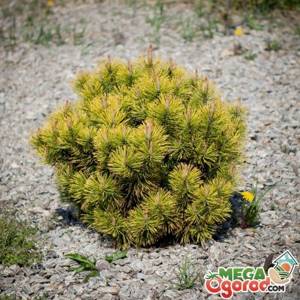
Description of culture
Pine (botanical name Pínus) is an evergreen tree, one of the most ancient species of the conifer family. Fossil remains of this representative of the earth's flora were discovered in sediments of the second period of the Mesozoic era.
Pinus is a monoecious plant. Its shoots, like other representatives of conifers, are of two types: on long leaves they have a scaly shape, on short ones they have a needle-like shape. Male flowers in the form of spikelets are located in the axils of the leaves, ovoid, scaly female cones are formed at the tips of young shoots. The seeds of most species are winged, ripen in 1.5-2 years, and, when spilled, can be carried by the wind for tens and hundreds of meters.
Related article:
Low ornamental trees
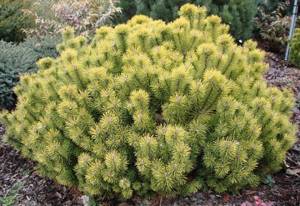
Some varieties of dwarf pines do not bloom or produce seeds; their main method of propagation is cuttings.
Pine is a medicinal plant known for many centuries, and all its parts have healing properties. The resin was included in the embalming compositions of the pharaohs of Ancient Egypt; analgesic and disinfectant compresses and poultices were made from infusions of pine needles. In modern medicine, pine needles, young buds and oleoresin (turpentine) are used - a resinous mass that is released when the bark is damaged. They contain disinfecting essential oils and resins, carotene, vitamins B and K, ascorbic acid, flavonoids, and tannins.
In many countries, pine is considered a magical tree endowed with magical powers. In China, Japan and Vietnam it is called the Tree of the Gods, a symbol of longevity, bringing happiness and averting troubles. It was customary to plant this plant near the palaces of emperors, and today decorative pines decorate almost every Japanese garden and Chinese garden composition.
Mountain low-growing varieties of pine trees
Below are the best mountain low-growing varieties of pine trees that landscape designers use when landscaping a site.
Little Lady
Little Lady is a dwarf shrub with a compact spherical crown. The height of the bushes reaches 20-70 cm. The length of the needles, painted in green tones, is in the range of 20-30 mm. The needles grow in bunches.
Frost-resistant bushes grow well in shaded areas. Wind-resistant branches do not break under a layer of snow. It is recommended to plant seedlings in slightly acidic, neutral, well-drained soil. The plant tolerates drought and can take root even in wetlands. Little Lady is not susceptible to pests.
March
Low-growing shrubs have a dense crown. The maximum height can reach 60 cm. The long needles are painted in dark green tones. It is recommended to plant dwarf pine in a well-lit area. On particularly hot days, it is worth shading green spaces with a special garden net. There are no special requirements for the composition of the soil. The March variety can be grown in open ground or in tubs.
Mini Pug
Mini Pug is a dwarf coniferous plant with a rounded crown shape. A slow-growing conifer plant grows slowly. Evergreen shrubs are literally dotted with short shoots. Every year the coniferous crop grows 2-2.5 cm taller. The needles are painted in dark green shades.
Laurin
The dwarf coniferous tree has a conical crown. Mature bushes reach a height of 55-75 cm. The diameter is within 100 cm. Soft and thin needles of a dark green hue grow in bunches and are naturally endowed with a pronounced pine aroma. A few cones are colored brown.
Kissen
The crown of the dwarf pine variety has a rounded shape. Hard needles are not densely located on the shoots. The annual growth of branches is in the range of 5.5-6.5 cm. The ripening of small brown cones lasts 24 months. An unpretentious plant takes root well in any soil.
The root system is well developed. Kissen is not susceptible to diseases and pests. With the help of a haircut, you can give the pine tree the desired shape. On hot summer days, it is advisable to shade the bushes with a special garden net to prevent sunburn.
Dwarf forms of pine and spruce
- VK
- Youtube
Among the wide variety of ornamental plants, low-growing and dwarf forms are especially popular in landscape design.
And although in the literature there is no clear definition of the term “low-growing decorative forms”, decorative forms of the species can be considered as such, the size of which in adulthood is several times smaller than the plants of the parent species. So, if the common spruce (Picea abies) reaches a height of up to 50 meters, the width of the crown is up to 8-10 m, then its decorative shape “cushion-shaped” ( Picea abies 'Nidiformis' ) reaches no more than 2 meters in height, and the width of the crown is up to 2 -3 meters. A distinctive feature of low-growing forms is the insignificant annual growth of shoots, which rarely exceeds 10-15 cm.
Advantages of dwarf and decorative forms
In modern landscape design, experts give preference to low-growing decorative forms, both coniferous and deciduous species, because they have many advantages.
Let's name just a few of them:
- They do not require large areas for cultivation, so in a small area they can be used to create bright decorative landscape compositions, or create a collection of plants;
- Most decorative forms are quite durable;
- Great variety in shape (creeping, pyramidal, conical, spherical, etc.) and crown size, color and size of needles and leaves;
- It is possible to use them both separately and together with tall species of trees and bushes;
- Predicted dynamics of plant sizes by height and crown shape configuration;
- More varied uses than the mother species. They are planted in rock gardens, rock gardens, Japanese gardens, mixborders, container culture (vases, decorative containers), flower beds, and so on;
- Dwarf plants are easier to maintain and care for (as a rule, they do not require formative pruning, frequent feeding, etc.)
Varietal diversity
Most coniferous species have low-growing and dwarf decorative forms. The authoritative German scientist Gerd Kruessmann in his book “Coniferous Species” (published in Russian translation in 1986) describes more than 1,200 taxa of coniferous species, including over 800 decorative forms of various coniferous species, a significant number of which are stunted and dwarf. Among deciduous trees and shrubs there are also such forms, but their number is much smaller.
Most decorative forms do not bloom or form seeds, so the main method of propagation is cuttings. But this method is not effective for all breeds. When propagating species that do not reproduce well by cuttings (decorative forms of pine, fir, some forms of spruce), grafting with a cutting or bud onto the maternal or related species is used. This method is the only one for propagating standard forms.
Unfortunately, in domestic nurseries the range of decorative forms, with rare exceptions, is very limited. To create mother plantations in nurseries for the purpose of preparing cuttings for propagation, or to create collections, the decorative forms indicated below can be purchased at domestic garden centers. They are presented in most European nurseries, and some are already in Ukrainian nurseries.
These decorative forms can be successfully grown and propagated in all climatic zones of Ukraine with appropriate soil fertility and moisture. To spread them in gardening and landscape design does not require special propaganda, because their very interesting and decorative appearance will do this for itself.
Dwarf and low-growing forms of pine
Of the wide variety of decorative forms of pine, the most attractive forms of mountain pine (Pinus mugo) are the following:
Pinus mugo "Pumilio" (Mountain pine "Pumilio"). The spreading shrub reaches up to 2.5 - 3.0 m in width and the same height. The shoots are of different lengths, densely spaced and directed upwards. The needles vary in length, but are often short. Widely distributed as an ornamental crop. It is not demanding on growing conditions - it can grow on poor, dry soils. Recommended for planting in groups or separately on the lawn, used for rocky slopes and rock gardens of considerable size.
Pinus mugo "Mughus" (Mountain pine "Mughus"). Found naturally in the Alps and Balkans. Spreading shrub up to 1.5 - 2.0 m in height, often creeping. The shoots are short, the needles are dark green and hard. Winter-hardy. Bears fruit. Propagated by seeds, cuttings (rooting up to 40%). Very often used in garden culture. Recommended for rock gardens, landscaping slopes, ravines. Effective both in group and single plantings on the lawn.
Pinus mugo "Gnom" (Mountain pine "Gnome"). A shrub with a dense crown, spherical in shape, up to 1 - 2 m wide and the same height. The shoots are short, densely spaced, with each shoot from last year often producing 3-5 new ones. The needles are dark green with shine, 3.5 - 4.5 cm long, densely located on the shoots. Indispensable for rock gardens. Can be planted in decorative containers and vases.
Pinus mugo "Mors" (Mountain Pine "Pug"). Dwarf, almost spherical shape, equal height and width. At 10 years of age it reaches up to 0.5 m in diameter. The shoots are very short. The needles are dark, greenish-blue, straight, 2-4.5 cm long and 1.5 - 1.8 mm wide. Undemanding to growing conditions. Recommended for rock gardens, rockeries and for growing in containers.
Pinus mugo “Winter gold” (Mountain pine “Winter gold”). Dwarf, shrubby form, grows very slowly. At 10 years of age it reaches about 0.5 m in height and about 1 m in crown diameter. The compact spherical crown has an interesting coloring of the needles. In summer it is painted in delicate bright green tones, but in winter it turns golden yellow. Can serve as a decoration for any garden. Frost-resistant. It is undemanding to soil and can grow on rocky soils.
Other, less common, but very attractive decorative forms of various types of pine include the low-growing decorative form of Scots pine Pinus sylvestris: “Watereri” (Watereri), “Globosa Viridis” (Globosa Viridis); Austrian pine Pinus nigra: “Nana” (Nana), “Brepo” (Brepo).
Dwarf and low-growing forms of spruce
There are even more low-growing decorative forms in different types of Spruce.
such decorative forms are very common in common spruce (Picea abies)
Picea abies "Nidiformis" ("Nidiformis", synonym - nest-shaped) Dwarf, dense shrub with a nest-like shape. At 10 years of age it reaches only 0.4 m in height and up to 0.8 -1.0 m in diameter. The shoots are thin, the needles are short, light green. Ideal shape for rock gardens, rock gardens and container growing.
Picea abies "Little Gem" `("Little Gem"). Dwarf hemispherical shape. At 10 years of age it reaches only 0.5 m in diameter. The shoots are thin, radially located from the middle of the bush, the needles are short, dark green. It is especially good in the form of standard forms. Recommended for rock gardens. Can be planted in decorative containers and vases.
| Picea abies "Little Gem" | Picea abies "Nidiformis" |
Picea abies "Will's Zwerg" Very good graceful dwarf form with a narrow conical dense crown. At the age of 10 it reaches a height of 1.0-1.2 m without losing its shape. The needles, as they grow back, are soft green and strongly contrast with the old ones, which remain dark green. Recommended for group and single plantings in small gardens.
The most popular among the low-growing forms of spruce (Picea pungens) is:
Picea pungens “Glauca Globosa” (“Glauca Globosa”). Low-growing decorative form with a wide-conical crown shape. With age, it grows more in width than in height, the shape of the crown becomes rounded. It grows slowly. Reaches up to 3 m in height and the same size in width. The needles are thick, slightly crescent-shaped, blue-white, about 2 cm long, prickly. Not picky about growing conditions. Resistant to smoke and soot. Recommended for rocky gardens and for growing in containers. Planted singly or in groups on the lawn, good in landscape compositions.
| Picea glauca "Conica" | Picea glauca “Daisy's White” |
Picea pungens "Glauca Globosa"
Canadian or gray spruce (Picea glauca) has a very popular form, which is quite common in Ukraine, this is:
Picea glauca "Conica" Low-growing decorative form. At 60 years of age, the height of the plants reaches no more than 4 m. The shape of the crown is strictly pyramidal, dense, its diameter in the lower part reaches 2 m. Unfortunately, it is quite often affected by spider mites, and in early spring it can get sunburned on the south side (the needles turn yellow and falls off). Effective in a variety of compositions: on the ground, in group plantings. Recommended for growing in containers on roofs, terraces, for group plantings near houses, for rock gardens and rockeries.
Mutations of the gray spruce "Konika" are quite common decorative forms: "Alberta Globe" (Alberta Globe), "Laurin" (Laurin), "Gnom" (Gnome) , which are very similar and are often sold under the same name "Konika". But in reality they are quite different, despite significant similarities. Therefore, it is advisable to buy these decorative forms, as well as others, directly from the manufacturer, and if in garden centers, then only with a label containing information about the name of the plant in Latin.
's White” Low-growing decorative form. Reaches a height of up to 3 meters, the diameter of the crown in the lower part is 1-1.5 m. The shape of the crown is pyramidal, dense. The main feature of this variety is the gentle yellow color of the needles when they grow, but in the summer the needles become light green. Recommended for growing in containers, for single and group plantings near houses. Can also be used for rock gardens and rockeries.
Using dwarf and low-growing forms of spruce and pine as New Year trees
Almost all of the above listed decorative forms of pine and spruce have a compact crown shape, as well as a compact root system and are ideally suited for growing in various containers - containers, flowerpots, boxes, etc. It is only important to choose the right soil mixture that meets the requirements cultivated species, make a drainage layer in the container, water regularly without drying out the soil, and periodically feed it.
Dwarf and low-growing forms of coniferous plants grown in containers can be successfully and effectively used as traditional New Year's decoration not only for the garden but also for the interior.
At the same time, in order for the plants to be used for many years, you need to follow very simple rules:
- The plant in the container should be well rooted. To do this, it is planted a year before its intended use in the interior.
- It is advisable to keep the plant in the house for no more than 5 days, placing it away from heating and heating devices. If the room has a heated floor, the container must be raised on a stand so that there is no contact of the flowerpot with the floor. It is better when the temperature in the area where the plants are located does not exceed + 18-20 Cº.
- The soil in the container where the plant is planted should be moist, but should not be overwatered. It is advisable to spray the plant at least once a day with a spray bottle.
- After 3-5 days of being kept in the room, it should be taken out to an unheated loggia or garden. You should find a protected place in the garden where there is partial shade. The container, in order to avoid severe freezing of the plant’s root system, should be thoroughly insulated (with leaves, sawdust, pine needles, peat, etc.), and the soil in the container should be well watered.
Rekovets Petr, dendrologist, chairman of the board of the Kyiv Landscape Club
Publication date: July 26, 2021
121916
Rekovets Petr
If you notice an error, select the required text and press Ctrl+Enter to report it to the editors
Comments:
You can add your comment. For this you need to register or log in.
| Igor555, 2010-12-19 11:41:16 Thanks for the article. I have bonsais formed from these pines, I’ll lay them out someday. Moreover, he took broken and diseased plants from the markdown. Now they are beautiful and I think if you sell them they will cost 10 times more than I bought them 2 years ago. |
adding a comment
Tips for choosing
When choosing seedlings in a nursery, you should pay attention to their appearance. The shoots should be symmetrically located, the crown shape of most varieties has the shape of a cone, and the needles are colored in rich, bright shades.
Note! The seedlings should not have red needles or bald spots.

